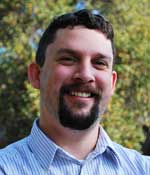Prize Recipient

Phillip S. Barbeau
Stanford University
Citation:"For pioneering work in developing a new type of germanium detector with the capability to measure very low energy nuclear recoils, with applications to the measurement of elastic scattering of reactor neutrinos, in searches for dark matter candidates, and for germanium based double-beta decay experiments."
Background:Phil Barbeau received his B.A. in Physics (with Honors) and his B.S. in Mathematics (with Honors) from the University of Chicago in 2001. He remained at the University of Chicago, receiving his Ph.D in Physics in 2009. At the University of Chicago, Dr. Barbeau worked with Prof. Juan Collar to develop new large mass, low threshold, low background detector concepts in order to search for coherent neutrino-nucleus scattering, low mass dark matter, and neutrinoless double beta decay. The work was part & parcel to the genesis of the ongoing CoGeNT experiment.
Currently Dr. Barbeau works with Prof. Giorgio Gratta at Stanford University as part of the EXO experiment, a liquid xenon detector designed to look for neutrinoless double beta decay. The EXO collaboration recently reported the first measurement of the two neutrino double beta decay mode of xenon-136.
